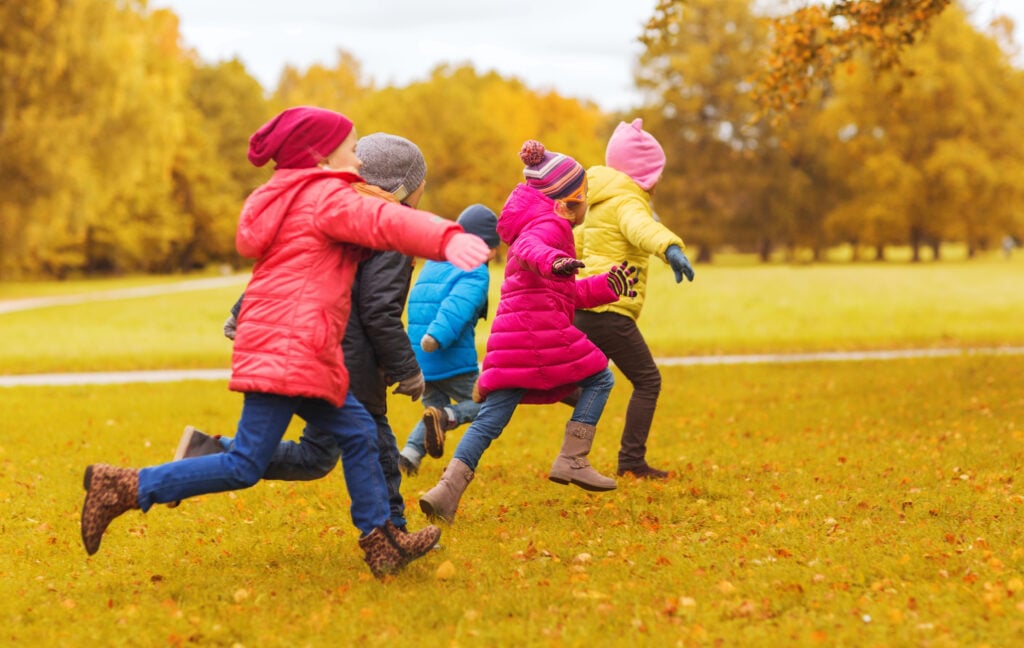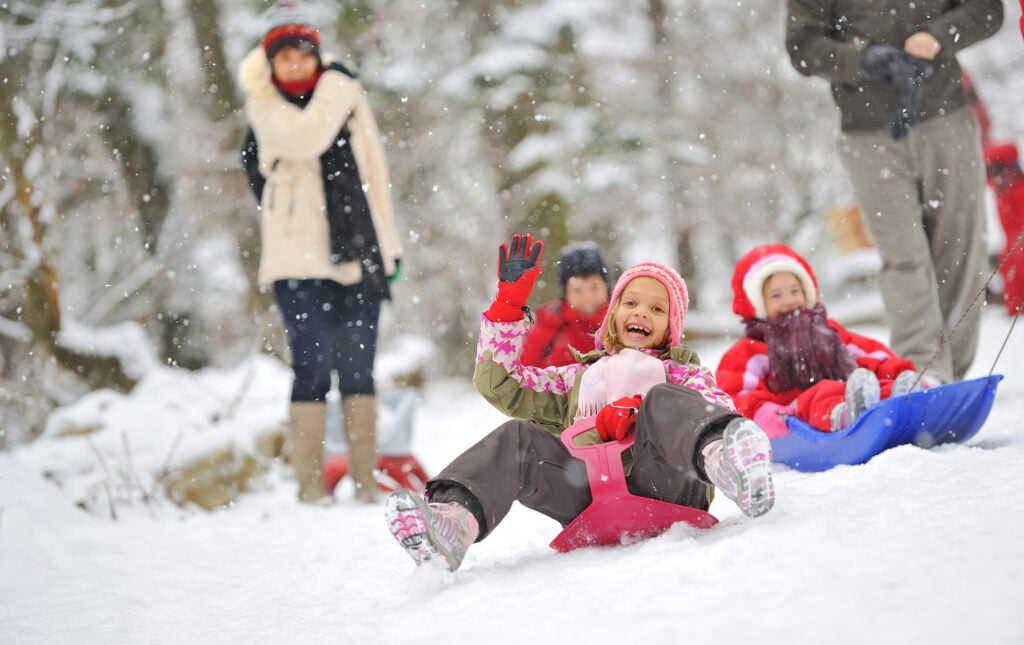
It’s that time when the holidays are around the corner, and the cold starts to creep in at night and in the morning. Colder temperatures signal a change in seasons, the need for coats, hats, and mittens, and often a change in how much time kids spend outdoors.
As parents, it can be a real pain to bundle up our kids to go outside (cue the missing mittens), and the idea of being outside in not ideal weather can be a turnoff. But is it really a good idea not to let your child play outside in what many people would consider “bad” weather?
Various recent studies have attempted to answer that question, and it probably won’t surprise many parents to learn that the benefits of outdoor play are numerous and incredibly important.
The Core Benefits Of Outdoor Play
According to the American Academy of Pediatrics (AAP), outdoor play is beneficial for all ages and boosts physical and mental health. For example, outdoor play has been shown to improve children’s physical health by increasing vitamin D absorption, increasing exercise, and reducing the risk of obesity.
What’s really exciting is that there are a ton of activities children can choose to engage in to improve their motor and gross motor skills, such as biking, running, skipping, catching, and other play.
And it’s not just the physical improvements, as a child’s mental faculties also benefit. The most apparent advantage of a child being in nature is an increase in curiosity and imagination, as they create with the items around them and invent games and worlds with the other children they play with in the great outdoors.
A global study led by Dongying Li, professor of landscape architecture at Texas A&M University, found that children who spend more time in nature grow into adults with stronger connections to nature, higher creativity, and greater sensory awareness. Supported by the Gulf Research Program and the National Academies of Sciences, Engineering, and Medicine, the findings highlight how nature exposure may help offset the effects of today’s screen-heavy childhoods.
- Sensory registration: Limited nature exposure is linked to a later inability to detect subtle sensory cues.
- Nature connection: More time outdoors in childhood leads to a stronger bond with nature in adulthood.
- Creativity: Early exposure to nature correlates with higher adult creativity.
- Sensory sensitivity: Those who spent more time in nature as kids show sharper senses of sight, hearing, and touch.
Research has also shown that children who are regularly outside have improved executive function (how our brains organize, plan, and implement tasks), enhanced impulse control, and reduced anger and aggression. Being outside in unstructured, non-adult-regimented play allows children to practice being alone with other children, learn to communicate, and practice self-control. These practices also help lead to better focus and decreased ADHD symptoms.
A 2023 study in China found a marked improvement in academic performance with increased outdoor play. A survey of more than 3,200 school-aged children, with an average age of 9, found that moderate daily outdoor time is linked to stronger academic performance. Researchers discovered a “sweet spot” around 2.3 hours per day, where time spent outdoors significantly improved scores in Chinese, mathematics, and English. Beyond that amount, the benefits plateaued. The study also found that sleep (up to 11.3 hours per day) was positively associated with academic outcomes, while extra study time beyond 1.4 hours per day outside of school offered no additional boost.
On a side note, researchers found that children who spent more than 1.4 hours per day studying did not show academic gains beyond that point, so keep that in mind when pressuring your children to study more! Maybe you should consider more outdoor time for your kiddos instead!
On frigid days, even a short time outside can work wonders. Studies have shown that spending as little as 5 minutes outside can improve mood, lower stress levels, and decrease depression symptoms. In our screen-driven world, constant noise and stimulus can easily overwhelm our children’s brains, causing anxiety and stress. Outdoor play and being in nature can easily help reduce those effects.
When your kids play outside regularly, the AAP says you end up with children who are:
- Physically healthier.
- More engaged in learning.
- More positive in behavior & mood.
- Mentally healthier.
Outside Time Means Increased Excercise
Despite these benefits, a recent survey of parents with children ages 1 to 5 found that 1 in 10 young children play outside once a week or less. For children aged six and older, the AAP recommends 60 minutes of moderate activity most days of the week. Outside play—biking, running around, climbing, crouching, swinging — are all forms of childhood exercise, and another reason to get your kids outside.
Don’t forget to join your kids! Adults, just like children, benefit from being outdoors and physical activity. Try playing some games with your kids, such as four-square, basketball, baseball, soccer, or just kicking a ball around. Play a family game of tag, make an obstacle course, or bike or walk around the block. You’ll both be releasing endorphins and boosting your moods, getting exercise, improving your sleep, and making family memories!
Getting your children active early in life could lead to a much healthier future. A long-term Swedish study published in the European Journal of Public Health, which followed 9,398 participants, found that adolescents who were more physically active had a lower risk of dying prematurely as adults. Regular exercise during adolescence strengthens the heart, muscles, and bones while improving emotional balance and focus. Just as importantly, it helps build healthy habits that often continue into adulthood. In short, staying active as a teen doesn’t just shape the body—it sets the foundation for a healthier, longer life.
I want to emphasize how important exercise is for our children and why getting them outdoors is so important:
- Helps teens make healthier, more active choices as adults.
- Builds lifelong fitness habits.
- Strengthens the heart, muscles, and bones.
- Supports focus, confidence, and mental health.
- Reduces the risk of chronic diseases later in life.
Part of life and learning is taking risks; we can’t protect our children from everything, and helping them grow in independence is part of our role as parents. Playing outside also allows children to take risks they wouldn’t take in indoor environments. It also helps children learn problem-solving skills in relation to other kids and pushing personal physical boundaries.
What About The Weather?

Contrary to popular opinion, you don’t get sick (or catch a cold) from being outside or from being cold. Illnesses are caused by bacteria and viruses—not by the weather or your body temperature. The runny nose you get from being outside in cooler temps is your body’s way of warming up mucus and helping prevent nasal irritation—not because of germs. UnityHealth points out that, yes, your immune system might dip slightly, but the actual cold isn’t what makes you ill.
While the cold weather may be a concern for some parents, simply wearing the appropriate layers and materials for the season can help your family enjoy time outside, no matter the season. I personally am a huge fan of the weather from April through September. I don’t particularly love winter, and I live in the north, where it can get very cold. A few years ago, I finally broke down and purchased some better winter gear, and now I actually like (mostly) going outside in the snow or even taking a walk on cooler fall days.
As a final note, my editor-in-chief recommends the 1,000 Hours Outside app. The goal is to reach 1,000 hours outside every year. He says that the app will motivate parents to get outside with their children when the warm months arrive, especially if they’re getting close to reaching the 1,000-hour goal for the year.
Here’s to many fun times outside this last fall and winter, even when the temperatures drop and our layers of clothing increase.

